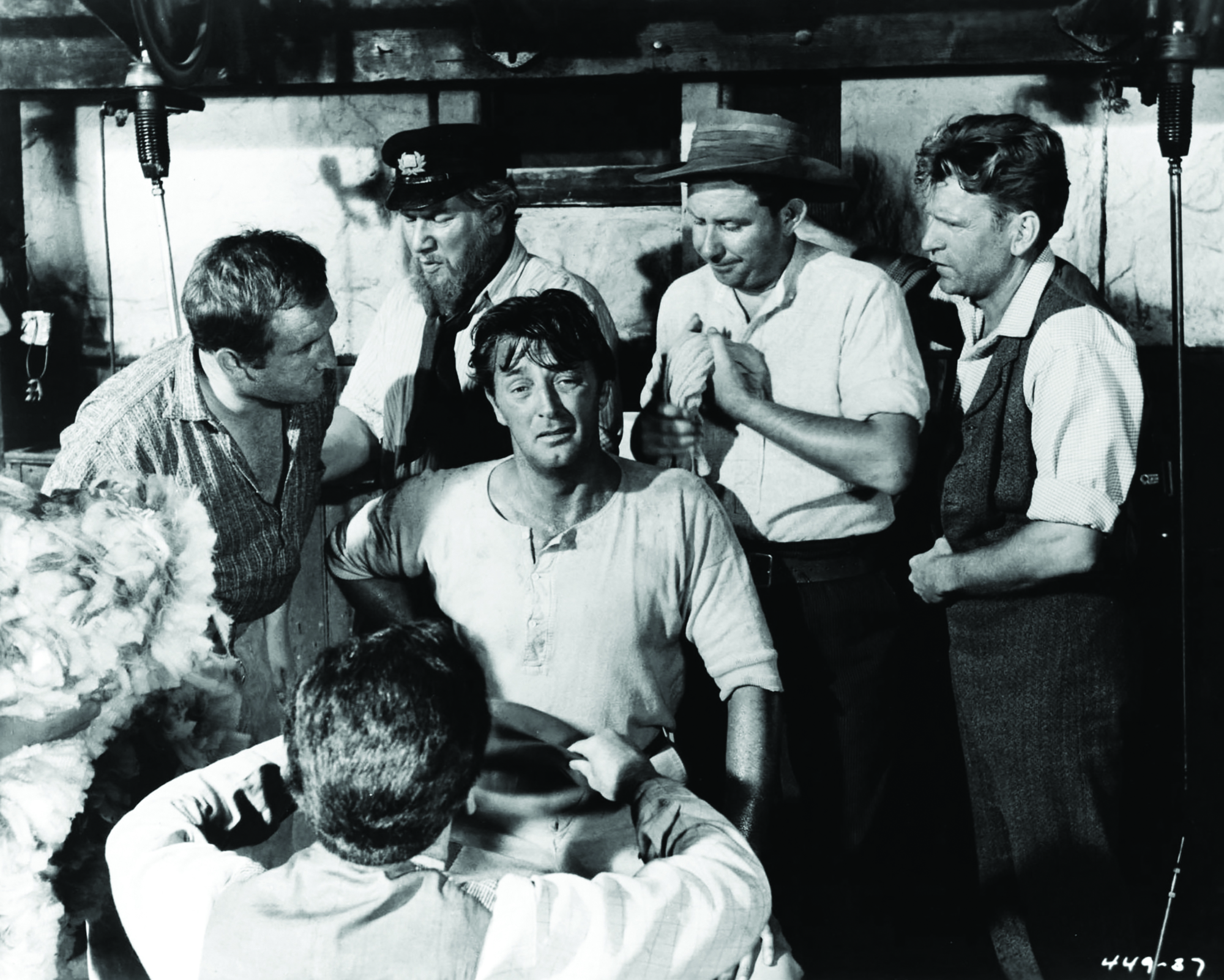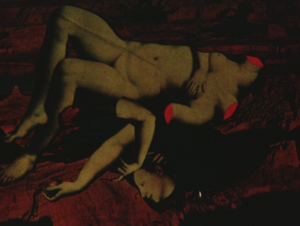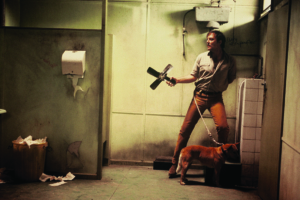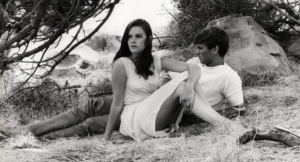Were we to shoot in America, it would emerge as a half-assed Western, with bars instead of pubs, cowboys instead of sheep drovers – they move differently, walk and react differently. Unlike in the Old West, no one carried guns in the outback. How could we reproduce the Aussie outlook on American locations? — Fred Zinnemann[1]Fred Zinnemann, Fred Zinnemann: An Autobiography: A Life in the Movies, Bloomsbury, London, 1992, p. 174.
When the renowned Hollywood director Fred Zinnemann came to Australia to make The Sundowners (1960), it was no part of his intention to stimulate the then-moribund state of the Australian film industry. His film was an Anglo-American production for Warner Bros.; it featured Hollywood stars (Deborah Kerr and Robert Mitchum) in the leading roles; and its technical team was mainly British, headed by top cameraman Jack Hildyard, who had recently won an Oscar for his work on The Bridge on the River Kwai (David Lean, 1957). The Australian contribution was mostly confined to the supporting cast, which included (inevitably) Chips Rafferty as a sheepshearing contractor, a young John Meillon as one of the shearers and a briefly glimpsed (and uncredited) Ray Barrett in a pub scene.
Yet, when one thinks of comparable Hollywood movies set in Australia, such as Kangaroo (Lewis Milestone, 1952) and On the Beach (Stanley Kramer, 1959), Zinnemann’s representation of the land and its people has a quite different ambience. It is odd to see the film sometimes described as a sort of American western in sheep’s clothing.[2]Among many examples, two will suffice to make the point: Christopher Tookey writes that ‘Fred Zinnemann’s picturesque yarn may be set in Australia, but it’s basically a big, family western about pioneering folk’ (see Tookey, The Critics’ Film Guide, Boxtree Limited, London, 1994, p. 822); and Jonathan Rayner describes The Sundowners as ‘an Anglo-American co-production which transplants the Western’s motifs to Australia wholeheartedly and uncritically’ (see Rayner, Contemporary Australian Cinema: An Introduction, Manchester University Press, Manchester & New York, 2000, p. 11). Zinnemann went to some lengths to avoid giving that impression, depicting activities such as droving and sheepshearing alongside dangers ranging from a prowling dingo to a forest fire that belonged to a specifically Australian landscape. When Warner Bros., for financial reasons, wanted him to shoot the film in Arizona, he refused (and because of the success of his previous film for the studio, 1959’s The Nun’s Story, he was in a strong bargaining position). He knew that the authenticity of the location was essential to the conviction of the film. Although it has been suggested that the film was partly Zinnemann’s homage to one of his screen idols, John Ford, it seems to me that the real inspiration behind his procedure was the man whom he described as his mentor and greatest influence: the so-called father of film documentary, Robert J Flaherty.[3]For more on Flaherty’s legacy, see Kelli Marshall, ‘Nanook and Robert Flaherty: Father of Documentary Film – and More’, Bright Lights Film Journal, 8 February 2016, <https://brightlightsfilm.com/robert-flaherty-nanook-1922-nyla-child-father-of-documentary-film-and-more/>, accessed 19 February 2021. As Flaherty did in pictures like Nanook of the North (1922) and Man of Aran (1934), Zinnemann in The Sundowners was showing a community and a way of life that had never been seen before in a mainstream Hollywood movie (the film’s trailer even describes it as ‘the untold story of [a] new kind of people’[4]The trailer can be viewed on YouTube; see ‘The Sundowners – Original Theatrical Trailer’, YouTube, 28 September 2015, <https://www.youtube.com/watch?v=ZD5N4oWbQM4>, accessed 19 February 2021.). More than in any film he had made since his debut, Redes (co-directed with Emilio Gómez Muriel, 1936), he was using Flaherty as his touchstone. In the process, however, he was also anticipating characteristics and concerns that were to come to prominence in the Australian film revival of the following decade.
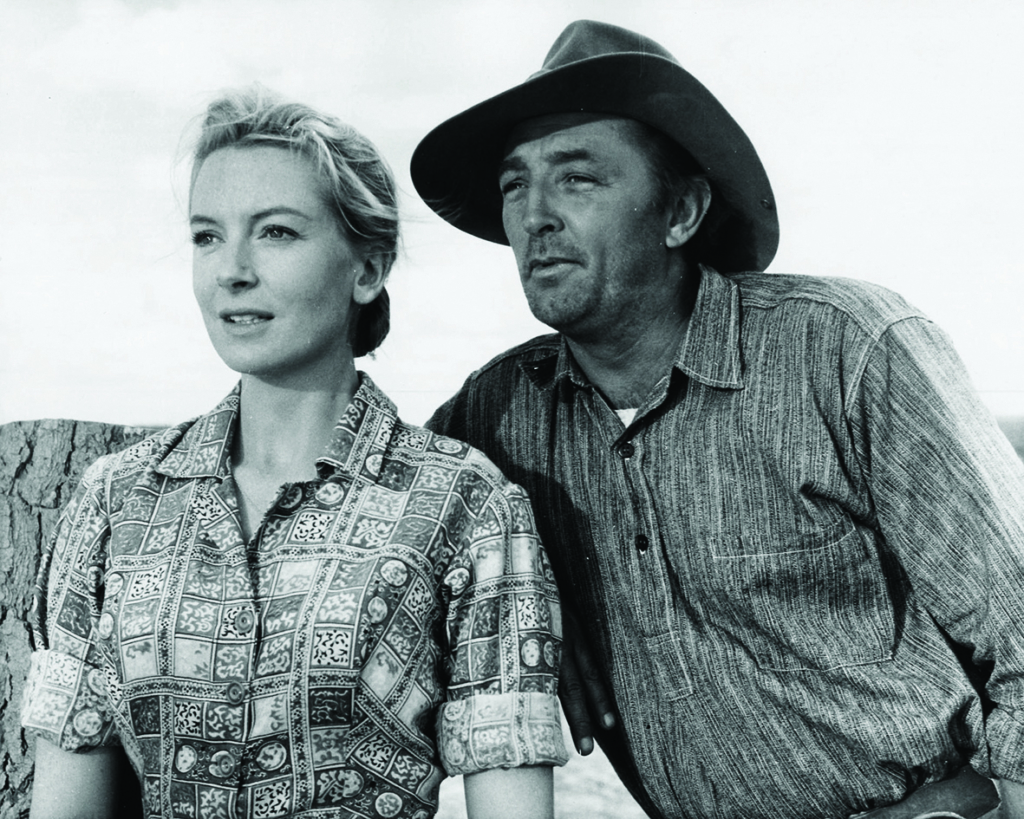
Origins of the film
The film came about indirectly through the director’s friendship with Dorothy Hammerstein, the wife of librettist Oscar, while he was making his film version of the Rodgers and Hammerstein musical Oklahoma (1955). Hailing from Tasmania, Dorothy encouraged Zinnemann to make a film in Australia, sending him novels to read that she thought might be potentially filmable. The one that captured his attention was Jon Cleary’s The Sundowners, first published in 1952 and set in the 1920s. He admired its evocation of landscape and the pioneering existence of people who lived in the Australian outback; and he had great affection for the main characters, Paddy and Ida Carmody, who are still in love after fifteen years of marriage and who, along with their teenage son, Sean, feel a sense of security in being together, even though all they own are the contents of their wagon and the shirts on their backs. Tension arises when Paddy’s incurable wanderlust comes into conflict with Ida’s increasing desire to settle down and have a farm of their own.
Dissatisfied with the first script he had received, Zinnemann recruited the experienced screenwriter Isobel Lennart, who submitted what he called a ‘good, if sentimental, version’[5]Zinnemann, op. cit., p. 174. (Zinnemann’s films are anything but sentimental). He then asked the novel’s author, Cleary, to assist in the adaptation. Cleary’s contribution was such that he was unfortunate to be denied a credit; this only occurred because the Writers’ Guild was on strike at the time and unable to arbitrate on his claim.[6]Cleary told me that, when the screenplay was subsequently nominated for an Oscar, Lennart contacted him to say that, if she won, she would acknowledge his contribution in her acceptance speech. However, the award went to Richard Brooks for his screenplay for Elmer Gantry (Brooks, 1960). Nevertheless, he told me that he enjoyed his experience on the film,[7]From personal correspondence the author had with Cleary when researching Fred Zinnemann’s film in the early 1980s. and was later to narrate a short documentary on its making. He was even given a small role in the final scene at the racetrack, wherein he tries to buy Paddy (Mitchum) and Ida’s (Kerr) racehorse after it has been disqualified, only to prompt their hearty laughter at the derisory sum he is offering. Zinnemann described that sequence to me as his homage to the ending of John Huston’s great film The Treasure of Sierra Madre (1948), in which the two prospectors find that their gold has blown away in the wind and their best response is to laugh at the vicissitudes of fortune.[8]From a range of interviews the author conducted with Zinnemann in the 1980s.
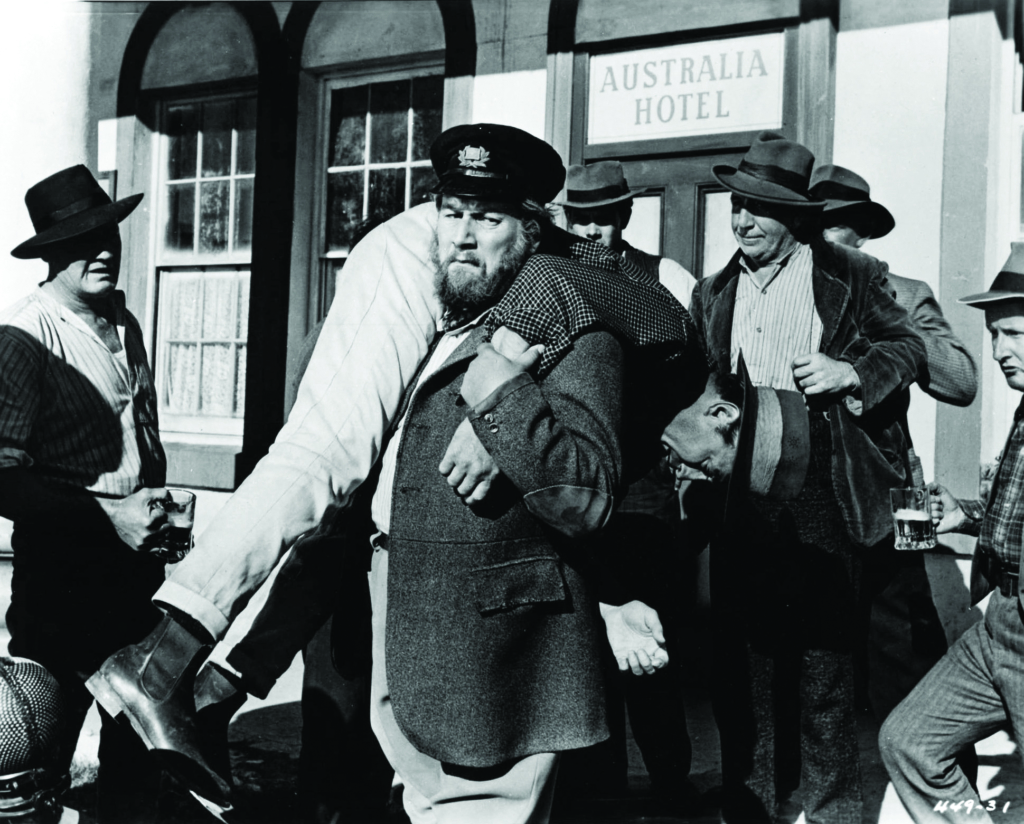
Adaptation and collaboration
Although there were inevitable changes from novel to screen, these tended to be subtle and nuanced rather than major, and met with the novelist’s approval. The ending, which foils Paddy’s noble attempts to atone for gambling away the family savings, is deftly handled in the film, maintaining the irony of the novel’s outcome, but arguably more wittily and concisely. Some of the harsher elements of the novel, like the destruction of a farmer’s home by a fire, have been omitted, but the film does not sentimentalise its source. For example, in the novel, the English remittance man Venneker, who has accompanied the Carmodys on their travels, decides to stay on and marry the bubbly hotel owner and widow Mrs Firth. In the film, however, Venneker (delightfully interpreted by Peter Ustinov) does not, feeling he is too old to change his ways. Mrs Firth (Glynis Johns) puts a brave face on her rejection; it’s only in her slightly clumsy and unsteady walk back to her car that one senses her shock of romantic disappointment. It is a poignant moment in Johns’ mostly effervescent performance. The novel’s tearful farewell between Venneker and Sean (Michael Anderson Jr) is transferred in the film to a more restrained parting shared between Sean and Bluey (John Meillon), the shearer with whom he has formed the closest bond. When Bluey says quietly that he hopes his newborn son will grow up to be like Sean, the boy turns away, flustered and overcome; adolescent embarrassment has rarely been conveyed more touchingly and truthfully on screen. In the novel, when the forest fire has subsided and Paddy has emerged safely, Ida says she would have gone back for him, if necessary. In the film, she does so; it is a wordless visual demonstration of the bond between two people who would literally go through fire for each other. Even tiny changes prove significant. In the novel, when a dingo threatens the sheep (implicitly, the family’s livelihood at that time), Paddy chases it on horseback and kills it. In the film, he chases it, but the dingo escapes. For all Paddy’s self-confident masculinity and protectiveness, the film is hinting that he will not always be able to deliver on his promises.
The casting makes no attempt to match the actors with the novel’s physical description of the characters. Ustinov’s Venneker is wider but smaller than the character in the novel. Cleary’s Paddy bears no physical resemblance to Mitchum, though the author told me that he thought Mitchum had ‘the right look of larceny in his eyes as Paddy’. He was similarly impressed with Kerr’s Ida, particularly in the film’s most famous scene, when she is waiting in the wagon by a railway track and becomes aware of an elegant passenger applying her make-up. Kerr’s face eloquently conveys a painful yearning for a kind of life which might always elude her; and when her gaze is returned, she seems to flinch involuntarily and looks down at her dress, as if sensing the passenger’s disdain at her ragged appearance. Originally there was a page of dialogue to follow when Paddy returns to the wagon, but the filming is so powerful that it was cut down to two lines. ‘What’s the matter, darl?’ Paddy asks, noticing that Ida is near to tears. ‘Nothing really,’ she replies. ‘In that scene,’ Cleary told me, ‘Fred taught me what the camera can do.’
Zinnemann had great affection for the main characters, Paddy and Ida Carmody, who are still in love after fifteen years of marriage and who feel a sense of security in being together.
Mateship
One minor difference between novel and film is particularly notable. After his stint as a sheepshearer – and even though he has agreed to take part in a sheepshearing contest against an elderly shearer from a rival team, Herb Johnson (Wylie Watson) – Paddy is now restless and determined to move on. It is the biggest family crisis so far, because Sean and Ida want to stay and the three of them have never been separated. When Sean suggests that they let Paddy go on without them, he is taken aback by the almost-brutal firmness of Ida’s rejection. ‘There’s someone waiting for you to spend the rest of your life with,’ she tells her son. ‘There’s no-one waiting for your dad and me but each other. Don’t ever ask me to choose between your father and you, because I’ll choose him every time.’ This speech is not in the novel, but it reinforces a crucial theme that Cleary wished to convey in his book and that, he told me, only Zinnemann had grasped:
The book was written partly to show a boy’s crossing the frontier between childhood and adulthood, but also to show the ‘mateship’ between a man and a woman in a marriage. The Australian tradition has been to show such mateship as existing only between men. I tried for another dimension and Fred was, I think, the first to see what I was aiming for.
The reason for Zinnemann’s awareness of this intention probably stemmed from its correspondence with an important aspect of his films that has been almost totally neglected in critical discussion of his work – namely, the theme of marriage. The critical tendency has been to give prominence to his heroes, such as Gary Cooper’s Marshal in High Noon (1952), Montgomery Clift’s Prewitt in From Here to Eternity (1953) and, later, Paul Scofield’s Sir Thomas More in A Man for all Seasons (1966), and the courage with which they act according to their conscience and convictions in the teeth of danger and oppression. Yet equally recurrent in Zinnemann’s work is the situation of a husband and wife who must battle through a difficult period in their marriage, which is invariably caused by masculine weakness or obstinacy. This is at the core of nearly all of his films between 1948 and 1960, from Act of Violence (1948) to The Men (1950), Teresa (1951), High Noon and A Hatful of Rain (1957), and reaching its culmination in The Sundowners. The wives in these films are not passive, but sensible and perceptive personalities, and the husbands are shown to need their support (it becomes a matter of life and death in High Noon). Important scenes between two women are a feature of these films – one thinks, for example, of the meetings between Janet Leigh and Phyllis Thaxter in Act of Violence and Grace Kelly and Katy Jurado in High Noon, and the superb final scene of From Here to Eternity between Deborah Kerr and Donna Reed – and there is a good example in The Sundowners, too, when Ida is visited in the kitchen by the farm owner’s wife, Jean (Dina Merrill), who still feels unsettled in the outback environment. An instant rapport is established between them even though their social backgrounds are completely different, and Ida’s strength will, over time, boost Jean’s self-confidence. ‘The men come here for the sheep, and we come here because of the men, and most of the women finish up looking like the sheep,’ Ida tells her, wryly. ‘Wrinkled faces, knotty hair, not even much of a mind of our own.’ But, as Jean avers, that would never be Ida’s fate. Her relationship with Paddy is a partnership of equals; and, whatever their future may hold, they will gain strength from facing it together.
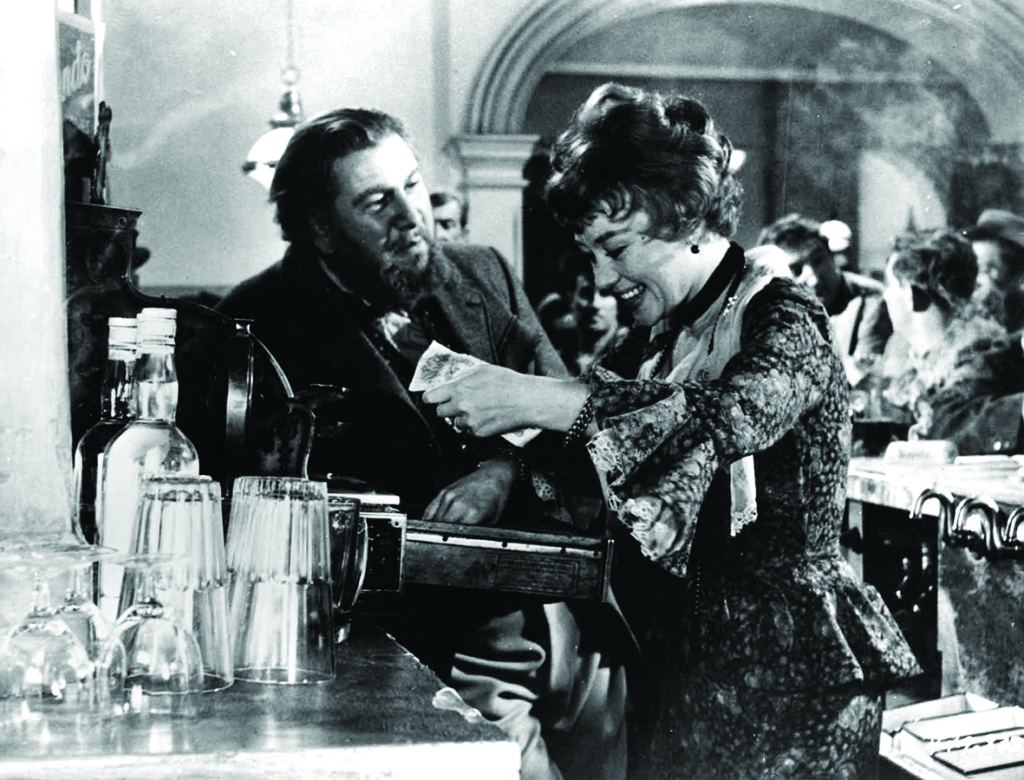
Zinnemann and Australia
The Sundowners is usually seen as a peripheral entry in Zinnemann’s cinematic CV, but it is arguably his most autobiographical film; it is clear that he was drawn to this particular Australian tale because he – possibly subconsciously – sensed a personal connection. The Carmody family set-up (husband, wife, teenage son) is closer to his own at the time of filming than in any other film he made. He would surely have empathised with aspects of Paddy’s character: notably, his stubbornness (as Stanley Kramer described Zinnemann to me, ‘Behind that quiet courtesy, there’s an iron rod’[9]From personal correspondence the author had with Kramer in the 1980s.) and his wanderlust (he was never happier as a director than when filming on a remote location). It would be idle to speculate on what strains these tendencies might have put on his own relationship; what is certain is that his marriage to costumer Renee Bartlett endured for over sixty years until his death and was, to judge from his autobiography, a happy one.
The Sundowners is Zinnemann’s most relaxed film, a drama in which every character is, to a greater or lesser degree, basically likeable. Even allowing for the torrid beach scene in From Here to Eternity, it is also his sexiest film; he makes no bones about showing the strong sexual attraction that still exists between Paddy and Ida. Above all, it has more humour in it than the rest of his films put together. The setting and material of The Sundowners seemed to liberate him; no other film of his ended with the sound of laughter.
The Sundowners is arguably Zinnemann’s most autobiographical film; it is clear that he was drawn to this particular Australian tale because he – possibly subconsciously – sensed a personal connection.
Although one could not argue for any direct link between The Sundowners and the Australian film revival of the 1970s, there are incidental connections. Serving as an (uncredited) assistant camera operator on the film was Nicolas Roeg, whose first solo feature as director, Walkabout (1971), was one of the most remarkable Australian films of that decade. The first venture of the South Australian Film Commission, Sunday Too Far Away (Ken Hannam, 1975) dealt with the harsh reality of sheepshearers’ lives in the 1950s, and was shot on the same location as the sheepshearing scenes in The Sundowners. In a review of The Irishman (Donald Crombie, 1978) in The Sun-Herald, critic Romola Costantino suggested that Zinnemann’s film might have been underrated, because ensuing Australian films had ‘worked the 1920s Australian scene to death. And here’s yet another one, taking its time showing the wide open spaces, the changing age, the young man growing up, country races, pub brawls.’[10]Cited in David Shipman, The Story of Cinema: Volume Two – From Citizen Kane to the Present Day, Hodder & Stoughton, London, 1984, p. 1152. All these features had been foreshadowed in The Sundowners. If it did not directly influence what was to come, Zinnemann’s sensitive, beautiful film was certainly looking in the right direction.
Endnotes
| 1 | Fred Zinnemann, Fred Zinnemann: An Autobiography: A Life in the Movies, Bloomsbury, London, 1992, p. 174. |
|---|---|
| 2 | Among many examples, two will suffice to make the point: Christopher Tookey writes that ‘Fred Zinnemann’s picturesque yarn may be set in Australia, but it’s basically a big, family western about pioneering folk’ (see Tookey, The Critics’ Film Guide, Boxtree Limited, London, 1994, p. 822); and Jonathan Rayner describes The Sundowners as ‘an Anglo-American co-production which transplants the Western’s motifs to Australia wholeheartedly and uncritically’ (see Rayner, Contemporary Australian Cinema: An Introduction, Manchester University Press, Manchester & New York, 2000, p. 11). |
| 3 | For more on Flaherty’s legacy, see Kelli Marshall, ‘Nanook and Robert Flaherty: Father of Documentary Film – and More’, Bright Lights Film Journal, 8 February 2016, <https://brightlightsfilm.com/robert-flaherty-nanook-1922-nyla-child-father-of-documentary-film-and-more/>, accessed 19 February 2021. |
| 4 | The trailer can be viewed on YouTube; see ‘The Sundowners – Original Theatrical Trailer’, YouTube, 28 September 2015, <https://www.youtube.com/watch?v=ZD5N4oWbQM4>, accessed 19 February 2021. |
| 5 | Zinnemann, op. cit., p. 174. |
| 6 | Cleary told me that, when the screenplay was subsequently nominated for an Oscar, Lennart contacted him to say that, if she won, she would acknowledge his contribution in her acceptance speech. However, the award went to Richard Brooks for his screenplay for Elmer Gantry (Brooks, 1960). |
| 7 | From personal correspondence the author had with Cleary when researching Fred Zinnemann’s film in the early 1980s. |
| 8 | From a range of interviews the author conducted with Zinnemann in the 1980s. |
| 9 | From personal correspondence the author had with Kramer in the 1980s. |
| 10 | Cited in David Shipman, The Story of Cinema: Volume Two – From Citizen Kane to the Present Day, Hodder & Stoughton, London, 1984, p. 1152. |
